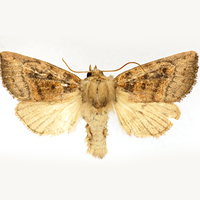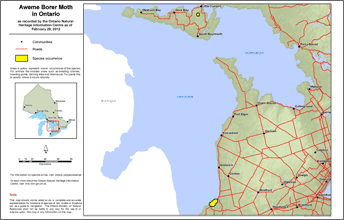Aweme borer moth
Scientific name: Papaipema aweme

Cover photo credit: Jocelyn Gill
Status
Endangered
“Endangered” means the species lives in the wild in Ontario but is facing imminent extinction or extirpation.
Date added to the Species at Risk in Ontario List
The Aweme borer moth was already assessed as endangered when the Endangered Species Act took effect in 2008.
What it looks like
The Aweme Borer moth has a wingspan that reaches up to 3.7 centimetres.
It is a yellowish or pinkish-brown with darker brown markings on the front wings and yellowish-white hind wings.
The body and head are dark brown. The larvae live on a host plant where they eat and grow until they transform into a moth. The host plant of this species is unknown.
Where it lives
Not much is known about the habitat needs of the Aweme Borer.
It may live in prairie habitats, such as sand dunes and oak savannas.
The pale colouring of the Aweme Borer allows it to blend in well with a sandy habitat.
Four of the five areas where the species has been collected in North America are along the Great Lakes shoreline.
Where it’s been found in Ontario
The sites where the Aweme Borer has been found are between southwestern Manitoba, east to the Great Lakes shoreline in northern Michigan, southern Ontario and northern New York State.
In Ontario, Aweme Borer has only been found at Grand Bend on Lake Huron and on Manitoulin Island.
View a Larger version of this map (PDF)
What threatens it
The greatest threat to the Aweme Borer moth is habitat loss or degradation as a result of agricultural or recreational development.
Natural threats include rodents, skunks, and woodpeckers. It is also vulnerable to the growth of trees and shrubs that change grasslands into forests, a process called natural succession.
Wild fire plays an important role in preventing natural succession and maintaining sand dunes and grasslands.
However, fire at the wrong times could also destroy the eggs and host plant of the Aweme Borer.
Pesticides that kill pests, such as the LDD moth, could also harm this species.
Action we are taking
Endangered Species and their general habitat are automatically protected.
Habitat protection
General Habitat Protection - June 30, 2013
Recovery strategy
A recovery strategy advises the ministry on ways to ensure healthy numbers of the species return to Ontario.
Read the executive summary (June 25, 2015)
Read the recovery strategy (June 25, 2015)
Government response statement
A government response statement outlines the actions the government intends to take or support to help recover the species.
Read the government response statement (March 23, 2016)
Review of progress
A review of progress made toward protecting and recovering a species is required no later than the time specified in the species’ government response statement, or not later than five years after the government response statement is published if no time is specified.
Read the report on progress towards the protection and recovery of 18 species at risk, including Aweme Borer Moth (2021).
What you can do
Report a sighting
- Report a sighting of an endangered animal or plant to the Natural Heritage Information Centre. Photographs with specific locations or mapping coordinates are always helpful.
Volunteer
- Volunteer with your local nature club or provincial park to participate in surveys or stewardship work focused on species at risk.
- Consider joining The Friends of Pinery Park, which has a mandate to help protect, preserve, and enhance the natural and historic heritage features of Pinery Provincial Park. For more information visit:
www.pinerypark.on.ca
Be a good steward
- Private land owners have a very important role to play in species recovery. If you find Aweme Borer Moth on your land, you may be eligible for stewardship programs that support the protection and recovery of species at risk and their habitats.
Report illegal activity
- Report any illegal activity related to plants and wildlife to
1-877-TIP-SMNR (847-7667) .
Quick facts
- Aweme is pronounced “ah-wee-mee”.
- An Aweme Borer was found on Manitoulin Island in 2005 – the first sighting of this species in almost 70 years.
- Even experts have a difficult time finding and identifying the very rare Aweme Borer, which is only active at night. Because the host plant for this moth is not known, finding this species is even more challenging.
- The Canadian range of the Aweme Borer accounts for three-fifths of the global sites where this species occurs. The first three specimens of Aweme Borer were collected at Aweme, Manitoba in 1905.
